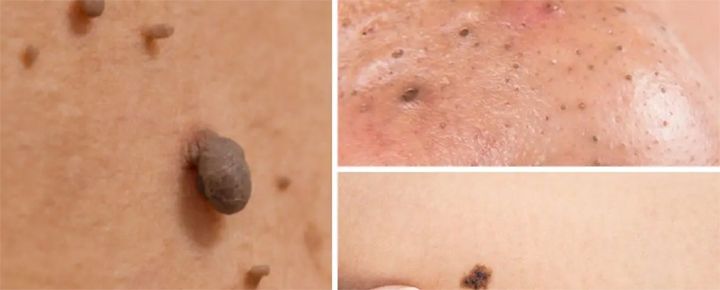Mole and Skin Tag Removal Options
 Moles and skin tags are both conditions where there is an abnormal outgrowth of skin. Skin tags are tiny, balloon-shaped, and soft growths growing out of the skin on a narrow stem. These are benign and harmless and commonly occur in skin areas such as the armpits, groin, neck, and on the eyelids. They are found more in zones where the skin folds such as under the breasts and buttocks.
Moles and skin tags are both conditions where there is an abnormal outgrowth of skin. Skin tags are tiny, balloon-shaped, and soft growths growing out of the skin on a narrow stem. These are benign and harmless and commonly occur in skin areas such as the armpits, groin, neck, and on the eyelids. They are found more in zones where the skin folds such as under the breasts and buttocks.
Moles are skin growths that develop from clusters of pigment cells, also known as melanocytes. They are more likely to occur on those skin regions that are most exposed to sunlight. Most moles are harmless and do not need any treatment; however, a few may convert into a dangerous type of skin cancer called melanoma.
You need not worry about a mole that stays unchanged. However, if you find that the size, height, color or texture of your mole begins to change, it is best to see a doctor. If you notice any other changes such as itching of the mole, or drying or scaling of the mole’s skin, or lumpiness in the mole, or bleeding, or some liquid oozing out of the mole, make sure you consult a doctor immediately for further examination.
Board certified plastic surgeon Dr. Gary Motykie provides mole and skin tag removal to patients in Beverly Hills, West Hollywood, Los Angeles, and surrounding communities.
Treatment for Skin Tags and Moles
Skin Tags
Doctors advise leaving skin tags alone unless they are a cosmetic issue or a cause of discomfort. Over time, if you notice any change in the nature of your skin tags, it is best to have a doctor examine them to decide if they need to be removed.
Removal of skin tags is a simple procedure and can be easily performed in the doctor’s office under local anesthesia. Common procedures include cutting or tying or freezing of the skin tag by using liquid nitrogen.
Moles
Regular moles generally don’t require any treatment; true moles will need surgical treatment with the help of a minor procedure such as excision of the lesion. These procedures are simple and easily performed in-office by a trained healthcare professional. Irregular moles that exhibit changes must be excised and sent to the laboratory for pathology which is a special examination of tissue.
Laser treatments are not advisable for moles although some centers and countries do use them. Use of fading and bleaching creams or chemical peels, or treatment with intense light pulses or liquid nitrogen may work for skin issues such as lentigines or sunspots; however, they are never used to treat melanocytic nevi.
Plastic surgeons specifically train for removal of skin growths. Most people have no or little discomfort following mole-removal surgery; only a tiny scar will remain following the procedure. Pain medication is generally unnecessary; any mild pain will respond to non-aspirin pain relievers that are easily available over-the-counter.
Cosmetic surgeon Dr. Gary Motykie receives patients from Beverly Hills, West Hollywood, Los Angeles, and nearby areas for mole and skin tag removal.
Contact Beverly Hills Board Certified Plastic Surgeon Dr. Gary Motykie to Schedule a Consultation
Click Here for Virtual Consultation
Click Here to Schedule a In Office Consultation
To see more services and treatments provided by Board Certified Plastic Surgeon, Dr. Motykie in Beverly Hills | Los Angeles | West Hollywood, CA and his team please visit:
